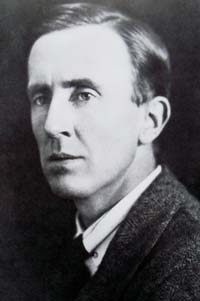THEY LIVED IN LEEDS
John Ronald Reuel Tolkien,
Writer, Poet, Scholar, Philologist (1892-1973)
 When J.R.R. Tolkien arrived in Leeds in the autumn of 1920 to take up the post of Reader in English Language at the University, he was an unknown young man of 28 on the threshold of his career. He had survived a difficult childhood and the horrors of war, and had already begun to write poems and stories about his imagined world of Middle Earth, its mythology, unique languages and fantastical inhabitants. But it would be many years before his work appeared in print and established him as one of the most popular and controversial writers of the twentieth century.
When J.R.R. Tolkien arrived in Leeds in the autumn of 1920 to take up the post of Reader in English Language at the University, he was an unknown young man of 28 on the threshold of his career. He had survived a difficult childhood and the horrors of war, and had already begun to write poems and stories about his imagined world of Middle Earth, its mythology, unique languages and fantastical inhabitants. But it would be many years before his work appeared in print and established him as one of the most popular and controversial writers of the twentieth century.
He was born on 3 January 1892 in Bloemfontein South Africa, where his father, a Birmingham bank clerk, had gone to improve his prospects. When he was four his father died, and his mother moved back to Birmingham with the two children. Money was short, and she had little support – she had alienated all her family when she converted to Catholicism (Tolkien and his brother remained devout Catholics all their lives). Tolkien won a scholarship to King Edward’s School and was prospering when suddenly and shockingly his beloved mother died from diabetes, untreatable before the discovery of insulin. She was 34, he only 12 – he had not understood how ill she was. He and his young brother were left penniless orphans, but were cared for by a compassionate Catholic priest who had befriended the family.
Tolkien persisted in his studies, displaying a remarkable gift for languages, and won a scholarship to Oxford where he focussed on Middle and Old English and Old Norse, rich sources of inspiration. Here, when he reached 21 in 1913, he was free to renew his romance with Edith Bratt, whom he had met and fallen in love with three years before. They got engaged in 1914 just as war was declared, and married in 1916 when Tolkien had completed his degree and enlisted – they knew he might never return. He fought in the devastating battle of the Somme, an experience that affected him deeply. In late 1916 he contracted trench fever and was invalided home. His recurrent poor health prevented his return to the Front, where all but one of his closest friends died.
When war ended, Tolkien and Edith, now with a young son, returned to Oxford where he found work with the New English Dictionary, but in 1920 he applied for the post of Reader at Leeds and to his surprise was appointed. Edith followed him to Leeds, with their newly-born second son, and they settled in a small terrace house, 11 St Mark’s Terrace, near the University. It was dingy and dark, and the sooty air rotted the curtains and covered the baby outside in his pram with smuts! In 1924, with a third child on the way, they moved to greener, pleasanter surroundings at 2 Darnley Road, West Park, Headingley, a tall Edwardian red-brick semi next to fields (still there – but no blue plaque).
The salary from the University was low, his office cramped, the English department small, but Tolkien was happy at Leeds, liked the students and found a congenial colleague in E.V. Gordon. Together they produced an acclaimed new edition of the Middle English poem Sir Gawain and the Green Knight. They shared a sense of fun too, and founded a University Viking Club – a feature was the recital of bawdy songs in Old Norse!
Tolkien adored his children and every Christmas from 1920 wrote them a ‘letter from Father Christmas’, wonderfully illustrated, with tales of adventures with the Snow-elves and other characters (these long-treasured letters were published in 1976). He clearly loved telling his children stories and inventing characters to amuse and thrill them, together with magical drawings and paintings. Many of these stories and images found their way into his later work.
Tolkien left Leeds in 1925 to take up the post of Professor of Anglo-Saxon at Oxford, where he remained for the remainder of his working life. His first published book The Hobbit, begun for his children, appeared in 1937, followed in 1954/5 by the three books of The Lord of the Rings, which became an international best seller and inspired an Oscar-winning cycle of films. The Silmarillion, edited by his son, was published after Tolkien’s death in 1973, as were many of his other works and papers. The extraordinary world he created continues even now to attract commentators and researchers, enthusiasts and critics.
Eveleigh Bradford
April 2012